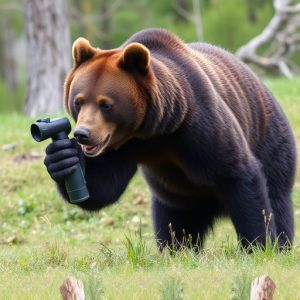Capsaicin Concentration: Understanding Bear Spray’s Effective Range
The effectiveness of bear spray relies on its capsaicin concentration, ranging from 1% to 4%, which…….
The effectiveness of bear spray relies on its capsaicin concentration, ranging from 1% to 4%, which irritates bears' senses and discourages attacks. Higher concentrations provide longer protection by targeting their respiratory system. Weather conditions and terrain impact spray range, and different bear species exhibit varying levels of fear towards capsaicin, making it crucial for safe interactions in bear-infested areas.
“Bear encounters can be intimidating, but understanding bear spray—a powerful deterrent—can mean the difference between safety and potential harm. This article explores the effectiveness of bear spray, focusing on the active ingredient: capsaicin. We delve into the science behind its deterrence capabilities, examining how capsaicin’s concentration in bear repellent impacts its range and real-world applications. By understanding these factors, outdoor enthusiasts can make informed decisions to protect themselves in bear country.”
- Understanding Bear Spray and Its Active Ingredient: Capsaicin
- The Science Behind Capsaicin's Efficacy as a Deterrent
- Determining Effective Range: Factors and Real-World Applications
Understanding Bear Spray and Its Active Ingredient: Capsaicin
Bear spray, also known as bear repellent, is a valuable tool for individuals navigating wild environments where bears are present. Understanding its composition and active ingredient is key to appreciating its effectiveness. The primary active component in most bear sprays is capsaicin, the same compound that gives chili peppers their heat.
The Capsaicin Concentration in Bear Repellent varies between products, but typically ranges from 1% to 4%. This concentration plays a crucial role in deterring bears. When sprayed, the capsaicin irritates the bear’s eyes, nose, and respiratory tract, creating an unpleasant experience that encourages the bear to retreat. Different concentrations offer varying levels of protection, with higher percentages providing longer-lasting and more robust defense against bear encounters.
The Science Behind Capsaicin's Efficacy as a Deterrent
The Science Behind Capsaicin’s Efficacy as a Deterrent
Bear spray, a powerful tool for personal safety in bear-infested areas, relies on capsaicin—the active ingredient found in chili peppers—as its primary deterrent. The effectiveness of capsaicin lies in its ability to interact with the bear’s sensory system, specifically targeting their olfactory (smell) and nerve receptors. When sprayed, capsaicin binds to these receptors, causing a sensation of pain and irritation similar to that of touching a hot stove. This reaction prompts bears to flee the area, as they associate the spray with a potentially harmful threat.
The strength of this deterrent effect is directly correlated with the capsaicin concentration in the bear repellent. Higher concentrations create a more intense irritant, increasing the likelihood of successful deterrence. Bear sprays typically range from 2% to 10% capsaicin by weight, with higher percentages offering longer-lasting protection and greater bear deterrence in various scenarios. Understanding the science behind capsaicin’s efficacy is crucial for choosing the right bear spray and ensuring safety during outdoor activities in bear country.
Determining Effective Range: Factors and Real-World Applications
Determining effective range for bear spray is a multifaceted consideration, influenced by several key factors. The primary determinant is the capsaicin concentration in the repellent—higher concentrations generally yield greater distances where bears are deterred. Weather conditions play a significant role as well; factors like temperature, humidity, and wind can impact both spray dispersion and bear behavior. For instance, lighter winds allow for better spray projection, while high humidity may reduce the concentration of capsaicin in the air.
Real-world applications further complicate range calculations. Terrain and vegetation act as barriers, breaking up the spray mist and reducing its effectiveness over distance. In open areas like alpine meadows, bear spray might be effective at ranges exceeding 30 meters (100 feet), whereas in dense forests or rugged terrain, that range could significantly decrease. Moreover, different species of bears exhibit varying levels of fear and avoidance responses to capsaicin, with black bears generally showing more deterrence than grizzly bears. Therefore, understanding these variables is crucial for users to ensure optimal protection when venturing into bear country.
In understanding the effective range of bear spray, factoring in capsaicin concentration is key. This potent active ingredient, found in many bear repellent products, has proven scientific efficacy against aggressive bears. By examining various factors such as distance, weather conditions, and bear behavior, we can determine optimal usage scenarios for these sprays. Knowing the specific capsaicin concentration ensures maximum protection during outdoor activities in bear country, providing a valuable tool to navigate and mitigate potential risks.

